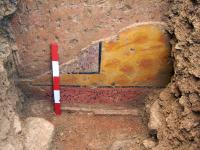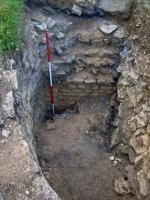 This season has been full of surprises, and the greatest surprise of
all came on the penultimate day. There is another Roman building
underlying the bath-house at Truckle Hill. This was a completely unexpected and very
exciting discovery.
This season has been full of surprises, and the greatest surprise of
all came on the penultimate day. There is another Roman building
underlying the bath-house at Truckle Hill. This was a completely unexpected and very
exciting discovery.
It had been difficult to explain the painted plaster wall outside the caldarium (hot room) but a new wall immediately outside the wall of the tepidarium (warm room) is clearly part of the same, earlier building. The excavated section includes a window opening, and the masonry work is of very high quality. This wall had also been decorated with painted plaster.
This first building was clearly luxuriously appointed with a mosaic floor (a small section of floor was found in situ at the base of the painted wall).
 Work
has continued all week in the first frigidarium (cold bath) and the
remains of the steps down into the bath have been uncovered. At more
than 1.5 m it was much deeper than expected and would have been more of
a plunge pool than a bath. Large pieces of roof tile from the collapsed
roof lay at the bottom of the frigidarium, together with blocks of tufa
which had formed the ceiling.
Work
has continued all week in the first frigidarium (cold bath) and the
remains of the steps down into the bath have been uncovered. At more
than 1.5 m it was much deeper than expected and would have been more of
a plunge pool than a bath. Large pieces of roof tile from the collapsed
roof lay at the bottom of the frigidarium, together with blocks of tufa
which had formed the ceiling.
Groups from the South Wiltshire Young Archaeologists’ Club and from
Hardenhuish School have been out to help excavate the area at the end
of the valley . It now seems almost
certain that this was the building site where large quantities of
mortar and plaster were produced for the bath-house, its predecessor
and the villa. This is exciting – it is unusual to find evidence of a
Roman building site.
. It now seems almost
certain that this was the building site where large quantities of
mortar and plaster were produced for the bath-house, its predecessor
and the villa. This is exciting – it is unusual to find evidence of a
Roman building site.
We end the season with lots of new questions. What was the connection between the first Roman building, the bath-house and the villa on the top of the hill? How large was the first building, when was it built and what was it used for? These are the questions which we hope to investigate next year.
We have many people to thank at the end of our 2008 season. First of all Mr Antony Little who has so generously allowed us to investigate the site. We would also like to thank Wiltshire County Council Archaeology Service and North Wiltshire District Council Community Awards for helping to fund this project and last but not least, the many volunteers who have helped in the excavation.
Tufa: soft limestone rock which forms beside water saturated with carbonates. Tufa is still produced in streams nearby.
